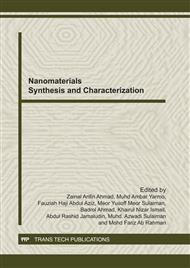p.460
p.465
p.470
p.475
p.480
p.485
p.489
p.494
p.500
A Study of the Nanostructure of the Cellulose of Acacia mangium Wood by X-Ray Diffraction and Small-Angle X-Ray Scattering
Abstract:
The purpose of this study was to develop practical and reliable small-angle x-ray scattering and x-ray diffraction methods to study the nanostructure of the wood cell wall and to use these methods to systematically study the nanostructure of Acacia mangium wood grown in Sabah, Malaysia. Methods to determine the microfibril angle (MFA) distribution, the crystallinity of wood, and the average size of cellulose crystallites were developed and these parameters were determined as a function of the tree age and the distance from pith towards the bark. The mean MFA in Acacia mangium increases rapidly as a function of the number of the year and after the 7th year-old it varies between 6° and 10°. The thickness of cellulose crystallites for Acacia mangium appears to be constant as a function of the tree age after 10-year-old. The obtained mean value is 3.20 nm. The size of the cellulose crystallites was also quite constant after 11 year-old. The maximum value of the width of the crystallites for Acacia mangium was 2.34 nm at the pith region, while the minimum value was 0.290 nm at the bark region. The mass fraction of crystalline cellulose in wood is the crystallinity of wood and the intrinsic crystallinity of cellulose. The crystallinity of wood increases from the 3nd year-old to the 10th year-old from the pith and is constant after the 10th year.
Info:
Periodical:
Pages:
480-484
Citation:
Online since:
October 2011
Authors:
Price:
Сopyright:
© 2012 Trans Tech Publications Ltd. All Rights Reserved
Share:
Citation:


